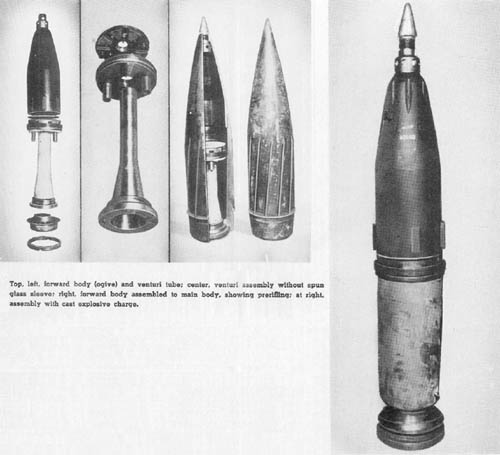
This high explosive projectile is fired from the 28 cm K. 5 (E) railway gun, and is prerifled in the same manner as the 28 cm Gr. 35 described on page 312. The outstanding feature of this new projectile is an increase in range from 67,800 yards to 93,100 yards—nearly 53 miles. This increase of 37% over the maximum range for the standard high explosive round is the result of energy supplied to the projectile by the addition of rocket propellant powder which is ignited 19 seconds after leaving the gun. After building up sufficient pressure to shear the lip on the base plug, the rocket propellant located in the ogive of the projectile discharges through a central venturi tube.
On the main body there are 12 steel splines set at the angle of rifling. The forward body (ogive) is threaded externally to screw into the main body and internally at its nose to receive the fuze and a rocket propellant ignition system. The venturi tube which extends from the base of the projectile to its middle section is secured by being screwed into the fuze and venturi adapter. A spun glass sleeve insulates the venturi tube from the explosive charge which is cast on the resulting assembly. A Zt. Z. S/30 time fuze set to operate 19 seconds after the projectile is fired is screwed into the nose of the projectile. Two percussion fuzes, AZ 4331, are located in the venturi adapter. These are armed by the burning of the rocket propelling charge through a powder pellet incorporated in the fuze. The rocket propellant is moulded as one piece, and extending through it are eight longitudinal holes 3/4-inch in diameter, located around a circular hole 1 5/8-inch in diameter.
SPECIFICATIONS
| Length of projectile (less fuze) | 48.79 ins. | |
| Diameter of ribs | 11.70 ins. | |
| Diameter of rotating band | 11.85 ins. | |
| Diameter of body | 11.10 ins. | |
| Total weight | 545 3/4 lbs. | |
| Rocket propellant weight | 43 lbs. | |
| Explosive weight | 30 3/4 lbs. | |
| Maximum range | 93,100 yds. |
German: p. 312.1 (June 1, 1945)